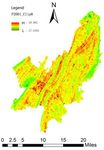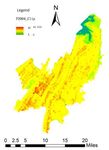Inversion and Analysis of Land Surface Temperature based on Landsat - a case study of BeiBei District in Chongqing
←
→
Page content transcription
If your browser does not render page correctly, please read the page content below
E3S Web of Conferences 165, 03006 (2020) https://doi.org/10.1051/e3sconf/202016503006
CAES 2020
Inversion and Analysis of Land Surface Temperature based on
Landsat - a case study of BeiBei District in Chongqing
Zhou Yang 1, Liu Na-na 1*
1 Chongqing Real Estate College,Chongqing 401331, China
Abstract: Land surface temperature is the surface of the earth's energy change and the exchange process,
which is an important index for a lot of scientific research. In this paper, the surface temperature changes of
BeiBei district in Chongqing in the past 20 years were inverted in 6 time phases. The surface temperature
inversion method of Landsat remote sensing data was studied, and the atmospheric correction method was
adopted to conduct the inversion by using Landsat5TM and landsat8OLI-TIRS image data. The results
showed that from 2004 to 2014, the area of high temperature area increased year by year, and the area of
low temperature area also increased year by year.
1Introduction BeiBei district is composed of the low mountain trough,
the foothill naked hill, the shallow hill and the river
Land surface temperature is the surface of the earth's valley. Within its scope the highest elevation is 1312m,
energy change and the exchange process, it is the the lowest elevation is 175m, so in the area of BeiBei
interaction between land and atmosphere comprehensive mountains and hills are more, flat dam is less, but the
performance of energy conversion, which is a very water system is very rich.The whole region is a natural
important parameter on the study of regional and global feature of "six hills, three mountains and one dam".
scales on the surface of a physical system, and which is Beibei district has the jurisdiction over Tiansheng Street,
also an important index for many scientific research [1-3]. Chaoyang Street, Beiwenquan Street, Longfengqiao
With the continuous development of remote sensing Street, Dongyang Street, Xiema Town, Jindaoxia Town,
technology, the using of thermal infrared remote sensing Sansheng Town, Shijialiang Town, Tongjiaxi Town,
data inversion of surface temperature becomes one of the Caijiagang Town, Liuyin Town, Chengjiang Town,
most commonly used methods at present. Jingguan Town, Fuxing Town, Shuitu Town, and Tianfu
Taking BeiBei district of Chongqing as the research Town, and it has a permanent population of more than
object, this paper used Landsat remote sensing image to 800,000.
invert the surface temperature of six phases from 2001 to
2017 and analyze them.
2.2 The data source
2 Research area overview and data This research uses the image data of Landsat5TM and
Landsat8OLI-TITS, and the ranks number of Beibei
source district is 137/039 and 137/040. In order to better study
the changes of surface temperature in BeiBei district
2.1 Research area overview over the past 20 years, according to the available images
and the purpose of obtaining accurate inversion data, we
Beibei district of Chongqing is located in east longitude try to select the image data with less cloud cover, good
106°18'14" to 106°56'53", latitude 29°30'41" to imaging quality and in the summer after analyzing all the
30°11'21", covering an area of 754.21km2. Beibei district image data, and finally we chose the images of six time
has a humid subtropical monsoon climate with abundant phase years of 2001-2017, respectively in 2001, 2004,
rainfall, characterized by early spring, hot summer, short 2007, 2011, 2014 and 2017. Their imaging time is from
autumn and late winter. The highest temperature is May to September, because during this time, the
44.3℃. The minimum temperature is temperature is higher.
-3.1℃, and the annual average temperature is 18.2℃.
Beibei district is a part of southwest col fold belt,
Huaying mountain geji-block compound anticline arc 3 Land surface temperature inversion
structure area Chongqing arc. The basic topography of
*
Corresponding author: 545195968@qq.com
© The Authors, published by EDP Sciences. This is an open access article distributed under the terms of the Creative Commons Attribution
License 4.0 (http://creativecommons.org/licenses/by/4.0/).E3S Web of Conferences 165, 03006 (2020) https://doi.org/10.1051/e3sconf/202016503006
CAES 2020
There are three methods of surface temperature inversion Sobrino was used to calculate the surface specific
using remote sensing images:atmospheric correction emissivity.
method (radiation transmission), split window algorithm, The formula is as follows:
and multi-channel algorithm. Among them, atmospheric
correction method is suitable for data sources of Landsat ε=0.004Pv+0.986 (1)
and TM/ETM+/TIRS series satellites. Combined with In this formula:
the image data selected in this study, surface temperature Pv—the vegetation coverage, which is calculated by
inversion using atmospheric correction method is the following formula:
adopted [4-6].
Pv = [(NDVI- NDVISoil)/(NDVIVeg - NDVISoil)] (2)
3.1 TIRS inversion flow chart based on In this formula:
atmospheric correction method NDVI—the normalized vegetation index;
NDVISoil—the NDVI value of the completely bare
The thermal infrared radiation luminance value L λ soil or non-vegetation covered area;
received by the satellite sensor consists of three parts: NDVIVeg—The NDVI value of the pixel completely
atmospheric upward luminance L↑, the energy of the covered by vegetation, namely, the NDVI value of the
ground's true luminance reaching the satellite sensor pure vegetation pixel.
after passing through the atmosphere; the atmosphere According to the empirical value NDVIVeg = 0.70
radiates downward to reflect energy as it reaches the and NDVISoil= 0.05, that is, when the NDVI of a certain
ground. pixel is greater than 0.70, the value of Pv is 1, when
According to the calculation formula of land surface NDVI is less than 0.05, Pv is 0.
temperature, this algorithm requires two parameters: According to the formula, the vegetation coverage
atmospheric profile parameters and surface specific image was calculated. Then calculate the surface specific
emissivity. The processing flow is shown in the emissivity.
following figure1.
3.3 calculation of blackbody radiation
brightness and surface temperature
According to the official website of National
Aeronautics and Space Administration(NASA) (http://
atmcorr.gsfc.nasa.gov), inputting the shadow time,
center latitude and longitude, and the other
corresponding parameters, we can obtain the
corresponding parameters: the atmospheric thermal
infrared transmittance τ, atmospheric radiation
brightness upward L ↑ and atmospheric radiation
brightness downward L↓.
Then, according to the formula, the black body
luminance image at the same temperature can be
calculated, and then the surface temperature image with
unit of Celsius can be further calculated.
4 Land surface temperature inversion in
BeiBei district of Chongqing
4.1 Inversion results
Fig. 1 TIRS inversion flow chart based on atmospheric
correction method The inversion results of surface temperature based on the
above surface temperature inversion method are shown
in the following figure2:
3.2 Calculation of surface specific emissivity
Specific emissivity is the specific performance of an
object's ability to emit electromagnetic waves to the
outside world. It is related to the composition, condition
and physical properties of surface features.
In this study, the calculation method of surface
specific emissivity is the same as that of TM/ETM+6
images. The NDVI threshold method proposed by
2E3S Web of Conferences 165, 03006 (2020) https://doi.org/10.1051/e3sconf/202016503006
CAES 2020
2007.09.20 40.28 19.09 25.74 1.46
2011.08.30 57.84 26.71 38.37 3.78
2014.08.06 47.82 13.36 32.74 3.32
2017.05.26 63.32 13.80 38.72 3.29
4.2 result analysis
In order to more clearly analyze the distribution law of
surface temperature in the research area, we used the
Robust Statistical method[7] to classify the temperature
image, and the formula for calculating the temperature
segmentation threshold is as follows:
T = A ± x × sd (3)
In this formula:
T—the calculated temperature threshold;
A—the average surface temperature;
x—a multiple of the variance(Values for 0.5,1,1.5);
sd— the variance of surface temperature
The temperature threshold calculated according to
the formula can be divided into 7 grades such as super
high temperature, sub-high temperature and super low
temperature (see table 2). According to the grades in
table 2, the temperature grade diagram can be obtained.
Table 2 classification of surface temperature
Temperature
t≤-1.5sd -1.5sdE3S Web of Conferences 165, 03006 (2020) https://doi.org/10.1051/e3sconf/202016503006
CAES 2020
2014 284327 282521 270237 5. Zeng Y, Huang W, Zhan F B, et al. Study
on the urban heat island effects and its
2017 183314 446831 207940
relationship with surface biophysical
characteristics using MODIS imageries[J].
5 Conclusion Geo-spatial Information Science, 2010,
13(1):1-7.
This paper describes the inversion of land surface
temperature and adopts the atmospheric correction 6. Becker, F. The impact of spectral
method based on the remote sensing data of landsat. emissivity on the measurement of land
Used Landsat5TM and image data Landsat8OLI-TITS. surface temperature from a satellite[J].
We choose six phases image data during nearly 20 years International Journal of Remote Sensing,
of BeiBei district in Chongqing. The results showed that
from 2004 to 2014, the area of high temperature area
1987, 8(10):1509-1522.
increased year by year, and the area of low temperature 7. Lin J., Chen S.L. ,Surface temperature inversion and
area also increased year by year, the influencing factors thermal environment analysis of xiamen island
of these changes may be closely related to urbanization based on remote sensing [J]. Journal of fujian
construction, population growth and urban greening and normal university (natural science edition), 2013,29
so on. (02) : 75-80.
Acknowledgements
I’d like to thank Chongqing education commission for
approving my research project "Image research of
urbanization on surface humid and thermal environment-
-a case study of Chongqing's nine districts", and I would
also like to thank Chongqing Real Estate College for
providing research fund support for this project, and the
last thanks to the efforts of the team members, we
believe that our project will get very good results.
Project source: Science and technology research plan of
Chongqing education commission in 2018 youth project
“Image research on the land surface temperature and
humidity environment of urbanization -- a case study of
the ninth district of Chongqing” (Project no. :
KJQN201805204)
Reference:
1. Chen Y.Y., Duan S.B., Ren H.Z., et al. Algorithm
development for land surface temperature
retrieval:Application to Chinese Gaofen-5 data.
Remote Sensing, 2017, 9: 161.
2. Fan X.W., Tang B.H., Wu H., et al. A three-channel
algorithm for retrieving night-time land surface
temperature from MODIS data under thin cirrus
clouds. International Journal of Remote
Sensing,2015, 36: 4836-4863.
3. Anderson M C, Norman J M, Kustas W P, Houborg
R, Starks P J and Agam N. 2008. A thermal-based
remote sensing technique for routine mapping of
land-surface carbon, water and energy fluxes from
field to regional scales. Remote Sensing of
Environment, 112(12): 4227–4241 [DOI:
10.1016/j.rse.2008.07.009].
4. Bredehoeft J D, Papadopulos I S. Rates of
vertical ground-water movement estimated
from the Earth’s thermal profile [J]. Water
Resources Research, 1965, (2): 325-328.
4You can also read























































